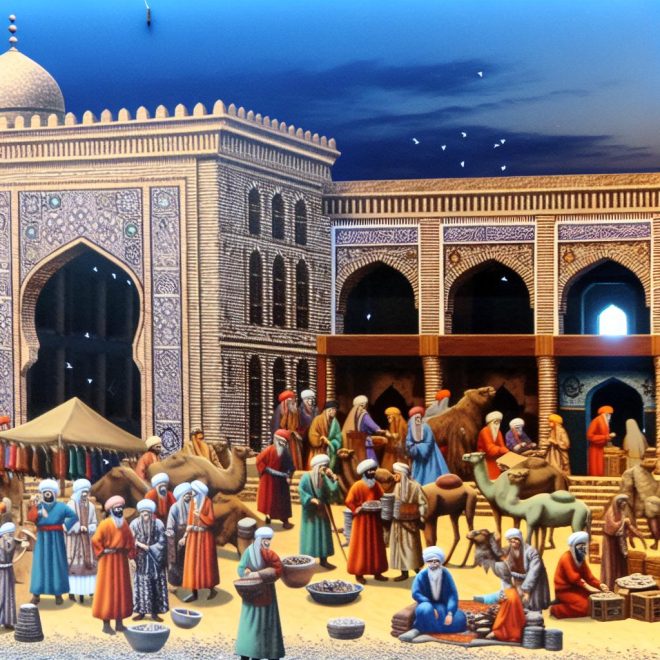The Caravanserai: A Pillar of the Silk Road Economy
The Silk Road, an expansive network of trade routes, was fundamental in linking the East and West over centuries. It was crucial in enabling not just commercial trade but also facilitating cultural and technological exchanges. Among the key infrastructural elements that supported this network were the caravanserais, which played a significant role in ensuring the smooth functioning of trade across challenging and often perilous landscapes. These structures were vital in sustaining the multi-faceted interactions that characterized the Silk Road, offering a snapshot of the dynamic interplay between commerce, culture, and technology in historical contexts.
What is a Caravanserai?
A caravanserai, in essence, was a roadside inn that provided a place for travelers to rest and recuperate during their journeys. These establishments were more than just a temporary shelter; they were strategically located along major trade routes, typically positioned so travelers could reach them within a day’s journey. Designed to meet the needs of both the merchants and their animals, caravanserais offered food, water, and resting facilities, thus ensuring that both man and beast could recover for the next leg of their journey. Horses, camels, and sometimes other pack animals used for transporting goods were taken care of at these stations. Since banditry was a common threat along the Silk Road, caravanserais were also constructed with security in mind, providing a safe haven against potential attacks and theft.
Functions of Caravanserais
Facilitating Trade: First and foremost, caravanserais were essential in supporting the continuous movement of a diverse array of goods. These goods ranged from luxury items such as silk, spices, and textiles to precious metals. The role of caravanserais as resting spots helped sustain this relentless flow of merchandise, which was the lifeblood of the Silk Road economy. By ensuring the safety and rest of merchants and their caravans, these establishments maintained the perpetuity of trade routes, enabling goods to move efficiently across vast distances.
Cultural Exchange: Beyond their economic role, caravanserais were melting pots of cultural exchange. Travelers from various regions and backgrounds convened at these inns, sharing their languages, customs, and ideas. This exchange broadened the cultural horizons of those who passed through, leading to a fusion of cultural practices and the dissemination of knowledge across continents. The intercultural dialogues that took place within the walls of a caravanserai enriched the regions along the Silk Road, leading to a vibrant intercultural dynamic.
Information Exchange: The role of caravanserais as communication hubs cannot be overstated. Merchants often used these stops to exchange vital information about trade routes, market conditions, and distant lands. This exchange of news and knowledge enabled merchants to make informed decisions, negotiate trade deals with greater confidence, and adopt new technological advancements. Caravanserais, therefore, were not only hosting people but were also epicenters of knowledge dissemination.
Architectural and Economic Importance
Caravanserais were designed with architectural precision to serve both functional and security needs. Typically, the structural design included fortified walls, a generously sized central courtyard, and designated areas for the accommodation of both humans and animals. These design elements ensured that security and operational efficiency were prioritized. The central courtyard was particularly significant, serving as a space where goods could be effectively stored, organized, and displayed, fostering a mini-marketplace environment.
On an economic level, caravanserais served as catalysts for local economies. The presence of these structures stimulated economic activity in their vicinity by creating employment opportunities, encouraging agricultural production, and fostering local trade. As local farmers and traders supplied food and other essentials to caravanserais, a localized micro-economy developed, enhancing the economic vibrancy of the regions they were in.
The Decline of Caravanserais
Despite their critical role in the historic trade ecosystem, the necessity for caravanserais gradually lessened over time due to several factors. The emergence of more advanced transportation methods and a shift in the political landscapes altered trade patterns significantly. Additionally, the development of maritime trade routes offered more efficient alternatives for transporting goods, further contributing to the decline of caravanserais. This transition marked a significant shift in global trade dynamics, diminishing the prominence of land-based trade routes. However, the legacy of caravanserais remains relevant today. Many of the former caravanserai sites have been preserved as historical landmarks, offering insight into a bygone era and continuing to attract interest from tourists, historians, and scholars.
The Modern Perspective
In modern times, caravanserais stand as enduring monuments to a crucial phase in global economic history. They embody the synthesis of commerce and culture, serving as a testament to the interconnectedness of ancient trade networks that shaped much of the known world. To this day, they remind us of the deeply interwoven past that connects diverse parts of our world through shared economic and cultural heritage. For those interested in further exploring the complexities of the Silk Road and its caravanserais, a variety of scholarly articles and books delve into their rich histories, offering a deeper understanding of their impact.
In conclusion, caravanserais were indispensable to the functioning of the Silk Road, facilitating not merely the exchange of goods but fostering the cross-pollination of ideas and cultures, playing a pivotal role in the economic tapestry of the era. Their multifaceted significance extends beyond their immediate function, highlighting their foundational role in linking diverse regions through trade and communication, ensuring the Silk Road was a dynamic and enduring conduit of the world’s intercontinental connections.
